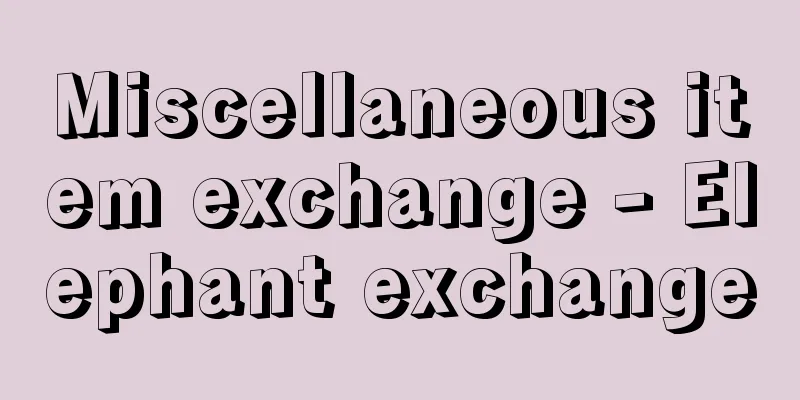Fujufusseha - Fujufusseha

|
A sect of the Nichiren sect. "Fusekuyo" means neither receiving nor giving, and is a sect rule and creed to protect the purity and purity of the faith of the Nichiren sect, in which people do not accept offerings from other sects and non-believers (those who slander the law), and believers do not give offerings to monks who slander the law. In the early stages of the formation and development of the Nichiren sect, this principle of not receiving or giving was excluded from the scope of authority of the imperial court and military (a system of not receiving or giving that excluded kings and nobles), but in the Muromachi period, the imperial court, military, and general believers were treated equally, with no discrimination, and it has been strictly observed as an ancient system since the time of the founder Nichiren. In 1595 (4th year of Bunroku), Toyotomi Hideyoshi built a Great Buddha Hall at Hokoji Temple in Higashiyama and held a memorial service for a thousand monks, inviting monks from the Nichiren sect along with monks from various sects. Nichio, who rejected this, and Nichiju, who was more flexible, came into conflict, and in the end, Nichiju's faction came to dominate, but this led to the debate over not accepting or giving alms. After Hideyoshi's death and the era of Tokugawa Ieyasu began, Nichio's claims were deemed to undermine the authority of the lord of the country, and he was exiled to Tsushima in 1600 (Keicho 5). In 1612, Nichio was pardoned, and in 1623 (Genwa 9), the Edo Shogunate granted official permission to the faction to not accept or give alms. However, there was constant conflict between the Kyoto side, which allowed donations to be accepted, and the Kanto mountains, which advocated not accepting or giving alms. At first, the Shogunate did not intervene in the conflict between the two factions, nor did it try to control them, but around 1660 (Manji 3), as the Shogunate's organization was established, it investigated the red seals of temple and shrine lands nationwide and issued new red seals. Here, a group naturally emerged, centered around the monks who did not receive or give (hochu) who had renounced their red seals and left the temple, who on the surface became ordinary parishioners of the Nichiren sect, Tendai sect, Zen sect, etc., but secretly believed in not receiving or giving (naishin), and others who had left the family register and become homeless, serving between the naishin and the hotchu (horyu).A secret religious organization was formed that linked the naishin, hotchu, and hotchu, and this was called the Fujubuse sect. The Fujubuse sect split into the Hizashi sect (Gyoryo sect) and the Tsuji sect (Komono sect) around 1682 (Tenwa 2) shortly after the formation of the sect, but in April 1876 (Meiji 9), Shaku Nissho of the Gyoryo sect revived the ``Nichiren sect Fujubuse sect'' and received permission to publicly use the name of the sect, and in March 1884, Shaku Nisshin of the Komono sect received official permission to establish the ``Nichiren sect Fujubuse Komono sect.'' [Yoshiaki Mochizuki] "The Origin and Development of the Fujubuse Sect, by Eisho Miyazaki (1969, Heirakuji Shoten)" "The History of the Martyrdom of the Fujubuse Sect, by Shin Aiba (1976, Okura Shuppan)" Source: Shogakukan Encyclopedia Nipponica About Encyclopedia Nipponica Information | Legend |
|
日蓮(にちれん)宗の一派。不受不施とは受けず施さずということで、日蓮宗以外の他宗および不信者(謗法(ぼうほう)者)の布施供養(ふせくよう)を受けず、信者は謗法の僧に供養しないという、日蓮教団の信仰の清浄、純正を守るための宗規であり信条である。この不受不施義は、日蓮教団の形成・発展の初期は、公武の権力者は枠外にあった(王侯除外の不受不施制)が、室町時代に入ると公武も一般信者も同等にして差別なしとされ、宗祖日蓮以来の古制として厳守されてきた。1595年(文禄4)豊臣(とよとみ)秀吉は東山の方広寺に大仏殿を建て千僧(せんそう)供養を営み、諸宗の僧とともに日蓮宗も招請した。これを拒む日奥(にちおう)と柔軟派の日重(にちじゅう)とが対立、結局、日重派が大勢を占めたが、ここに不受不施の論争が展開することとなった。秀吉が没し、徳川家康の時代となると、日奥の主張は国主の権威を損なうものとして1600年(慶長5)対馬(つしま)に遠流された。1612年日奥は赦(ゆる)され、23年(元和9)江戸幕府は不受不施派に公許状を与えた。しかし、布施を受けることを認める京都側と、不受不施を主張する関東諸山はつねに対立した。幕府は初め、2派の対立抗争に介入せず、統制下に置くこともなかったが、1660年(万治3)ころ幕府機構の確立とともに全国寺社領の朱印を調査し、改めて朱印を下付した。ここに、朱印を放棄し出寺した不受不施僧(法中(ほっちゅう))を中心に、表面は一般日蓮宗や天台宗、禅宗などの檀家(だんか)となり内心に不受不施を信ずる(内信(ないしん))者と、自ら戸籍を脱して無宿の者となり内信と法中の間にあって給仕する(法立(ほうりゅう))者とが自然に生まれ、内信―法立―法中と連係する秘密の教団組織が形成され、これを不受不施派という。不受不施派は教団形成後まもない1682年(天和2)のころ日指(ひざし)派(尭了(ぎょうりょう)派)と津寺(つじ)派(講門派)に分かれたが、1876年(明治9)4月、尭了派の釈日正(しゃくにっしょう)が「日蓮宗不受不施派」を再興し、派名公称の許可を得、84年3月に講門派の釈日心(しゃくにっしん)は「日蓮宗不受不施講門派」の公許を得た。 [望月良晃] 『宮崎英修著『不受不施派の源流と展開』(1969・平楽寺書店)』▽『相葉伸著『不受不施派殉教の歴史』(1976・大蔵出版)』 出典 小学館 日本大百科全書(ニッポニカ)日本大百科全書(ニッポニカ)について 情報 | 凡例 |
Recommend
Academy of American Franciscan History
…Their subsequent activities probably covered the...
Corporation Law - Kabushiki Gaishaho
...The main points of the law were (1) to facilit...
Clerodendrum japonicum (English name) Clerodendrum japonicum
…[Kazuo Furusato]. … *Some of the terminology tha...
Mejina (English spelling) largescale blackfish
A marine fish belonging to the order Perciformes ...
Green corn - Aogari corn
… In Japan, corn is classified according to the t...
Omphalocele hernia
…Umbilical hernias are when the intestines protru...
Juntaro Ishihama
1888-1968 A scholar of Oriental history from the ...
Konden - konden
It is pronounced "harita" and can also ...
Bean goose (English spelling)
A bird of the Anatidae family (illustration). In J...
Adsorption - Adsorption
When two phases are in equilibrium, the concentra...
Ust-Orda Buryat National District - Ust-Orda Buryat National District
The republic's name was changed to "Bury...
Alumina cement
Also called fused cement. A hydraulic cement whos...
Exchange arbitrage
It is an operation to earn interest by taking adv...
Nanak - Nanak (English spelling)
A medieval Indian religious leader. The founder o...
Elliptic equation - elliptic equation
A type of partial differential equation. The basic...


![Evros [river] - Evros](/upload/images/67cfaa2790b3d.webp)

![Hayama [town] - Hayama](/upload/images/67cc8eabc249c.webp)




